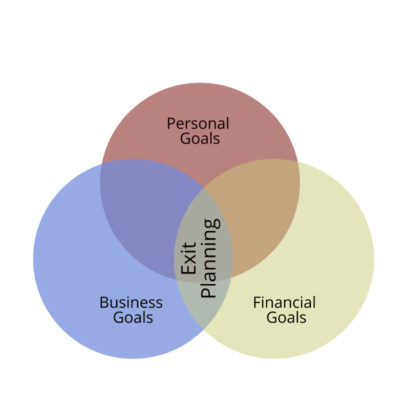Exit Planning is the Development of a Comprehensive Strategy

A Certified Exit Planning Advisor (CEPA) will assist you to craft a dynamic strategy which will allow you as an owner, to be ready for an exit on your terms. There is no best time to exit your business; but, there is a worst time – when you are not prepared and you need to exit. Too many owners exit their business when they don’t have a choice because of external factors such as their health, the economy, or other unforeseen circumstances.
Recent studies show that 66% of the current American business market is owned by Baby Boomers, who are set to transition over the next zero to ten years. Statistics also show that only 20%-30% of businesses that go to market actually sell; leaving up to 80% of those without solid options to harvest their wealth and ensure economic continuity into the next generation. An owner who is “ready” with an attractive business greatly increases the odds that the business will survive a transition of hands. The question is, how ready are business owners?
For a successful exit, your goals need to be aligned

A successful exit depends on the alignment of your personal, business, and financial goals. If one of these three is missing or worse, ignored, an exit will not be successful. Transitioning a business, therefore, must consider the holistic nature of the issues surrounding retirement finances, business continuation, and lifestyle.
Exit Planning is not a DIY Project
In order to successfully develop and execute an exit plan, input and advice is needed from a range of professional advisors. There are almost always financial planning, tax, and legal issues that need to be resolved in order to make the strategy successful. The exit planner may fulfil one or more of the roles on the team, as well as acting as a coach or quarterback for the exit planning team.
Value and Income
Most small business owners manage their companies to maximize their income after taxes. Many times that means that they sacrifice value for income. Value is built by changing this paradigm. To create value a business owner needs to create sustainable income by cultivating a management team that can operate without everyday supervision using repeatable processes. A business that is built for sale needs to have consistent sales to multiple, repeat customers. An owner who carries the water for the sales organization does him or herself no favours when it comes to valuing and selling the business.

The CEPA® Value Acceleration Process
he Value Acceleration Process provides a framework to help business owners with Business Transition Planning. Ideally, the process of exit planning should take place well before a transition is contemplated. In this way, if an exit is necessary because of an unexpected event (disability, death, etc.) there is a strategy for the exit and sufficient value has been created for a successful transition to take place.
If a business transition is well planned and the exit takes place when it is strategically timed, all of the parties involved will be clear about the part they play in making the exit successful for the family, business, and executives. Don’t fool yourself, if you are over 60 your key employees are wondering what will happen when you retire – they are thinking about their contingency plans because they don’t know your plans.

Frequently Asked Questions
The team needed to successfully create the plan, build company value and then bring to market will utilize your current advisors (CPA, attorney, Financial Planner, etc.) as well as outside advisors when needed.
Your Certified Exit Planning Advisor (CEPA®) will lead the process and help each advisor understand your goals and their roles in the process. True collaboration amongst professional advisors is essential in achieving the owners’ goals in a time-efficient manner while controlling mission drift.
Typically, the discovery or triggering event is quoted as a fixed fee. The fee will depend on the size and complexity of the business and the personal situation of the owner.
For the ongoing work as a quarterback to the exit planning process, we will charge either by the hour or charge a monthly fee depending on the actual work contemplated. In addition to the fees we charge, you should expect to pay fees to your other professionals (CPA, Attorney, Financial Planner). In our experience, the fees paid to other professionals are typically lower when an exit planning professional is involved to co-ordinate their work and facilitate communication and teamwork between the advisors.
There is an old saying that the best time to plant a tree is thirty years ago, and the second-best time is now. When it comes to exit planning, the second-best time to begin is now.
Creating an Exit Plan at least three years in advance of selling the company gives you time to enhance the business value before bringing the company to market. A three-year window allows the owners to identify what value drivers need their attention and then to make the required adjustments within their businesses. You never know when a business opportunity may present itself and you want to be ready when it comes. If you don’t have three years, we can implement some, but not all, of the strategies and techniques normally used to enhance your satisfaction upon exiting your business.
Often referred to as business succession planning, exit planning is the development of a strategy that enables the business owner to maximize value and leave their business on their own terms.
As a Certified Exit Plan Advisor, we typically Implement the strategy using the Exit Planning Institute “Value Acceleration Methodology. The strategy correlates the owners personal, financial, and business planning together to build a set of action steps to accomplish short and long term goals.
The first phase in the methodology is to discover the current state of the owner and business readiness by doing an assessment of the personal financial plan, a company valuation, and a personal assessment. During this discovery step, we will enumerate the gaps that exist in each of the three areas and build a plan to close the gaps.
The second phase is to put the plans into action and is accomplished in several steps. We start with actions to de-risk the owners business and personal situation. Typically actions taken during this step involve securing key man insurance, putting in place buy-sell agreements, writing employment contracts with key employees and customers, and creating a comprehensive estate and charitable giving plan.
The second step in this phase is focused on closing the profit and value gaps discovered in phase one in order to enhance the value of the business. During this step we may introduce a marketing or operations consultant to drive the sales and increase operating efficiency. If resources exist at the company, the exit planner may coach a number of employee teams to drive these initiatives – during this step, it is essential to pursue a strategy of “relentless execution”. Projects are broken down into 90 day initiatives with S.M.A.R.T goals. This phase may be continual and repeat every 90 days to foster an atmosphere of continual improvement.
The last phase involves analyzing the available exit options. We consider several inside and outside options for a business exit. Inside options we review are:
Sale to partners
Management Buyout
Sale to employees (ESOP)
Intergenerational Sale
Outside exit options include:
Sale to a third party
Recapitalization
Sale to PE firm
Orderly liquidation
Because the business and personal situation are always fluid, we regularly review the question of whether it is time to exit and which exit option makes the most sense. If an unsolicited offer is received we already have a framework within which to evaluate the offer and its timing with respect to the owners’ and the businesses readiness to exit.
Your attorney (CPA, Insurance Provider, Financial Planner, etc.) is probably very qualified. We have found that most of these professionals are excellent when it comes to working within the scope of their profession. But, do you think your attorney could do a future cash flow projection for the business? Could your CPA produce the legal documents needed for the sale of the business? How about your Insurance Provider? Could he or she develop a certified valuation of your business that would stand up to the scrutiny of the IRS?
Most professionals do great work in a relatively narrow field. As Exit Planning Professionals, we oversee the entire process to make sure that each professional provides the appropriate documents at the correct time. In other words, we develop your plan, coordinate everything and give you the peace of mind of knowing that everything is under control.
